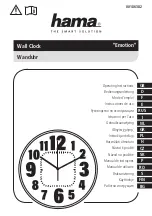
La Crosse Technology, Ltd. www.lacrossetechnology.com/support
Page 3
Quick Connect
Explanation: Use the quick connect for an atomic clock and remote sensor that have been working but lost
connection due to interference or low batteries. This is not the same as a thorough factory reset.
1.
Bring the remote sensor and atomic clock together inside, and place the units 5-10 feet apart with
nothing between them.
2.
Hold the MINUS button for 5 seconds. The remote temperature area will flash.
3.
Remove battery cover from the remote sensor and press and release the TX button to send the signal.
4.
Wait for 2 minutes for the remote temperature to appear on the atomic clock.
If the above procedure does not work, please try the factory reset.
Remote Temperature Signal Strength
Explanation: The atomic clock will search for the remote temperature remote sensor for 3 minutes after
batteries are installed or when the MINUS button is held for 3 seconds.
The antenna symbol will flash during reception.
The temperature display will be dashes “---“.
If synchronization fails once, the antenna will lose one bar.
If synchronization fails twice, the antenna will lose two bars.
If RF (radio frequency) reception fails five times, the antenna symbol will show without bars.
The antenna will show full display with successful RF (radio frequency) reception.
Dashes show for Remote Temperature
Explanation: Dashes mean the connection is lost between the atomic clock and the remote sensor.
often resolve the connection.
can cause loss of connection between the remote sensor and the atomic clock.
Turn the atomic clock 90 degrees towards the remote sensor to provide better reception. This allows
more antenna surface to face the remote sensor signal.
Try the
Power Requirements
2-AA
power the remote sensor.
2-AA
power the clock.
We recommend Alkaline batteries for the remote sensor.
You may choose to use Lithium batteries for temperatures below -20°F/-28.8°C.
Inaccurate Remote Temperature Reading
Explanation: High remote temperature readings are generally a location issue. Low remote temperature
readings are power related or a sensors going bad.
The remote sensor reads the environment where it is mounted. When mounted inside the home, it will
read inside temperature.
When the remote sensor reads high during the day, but not at night, it is a
positioning
problem.





























